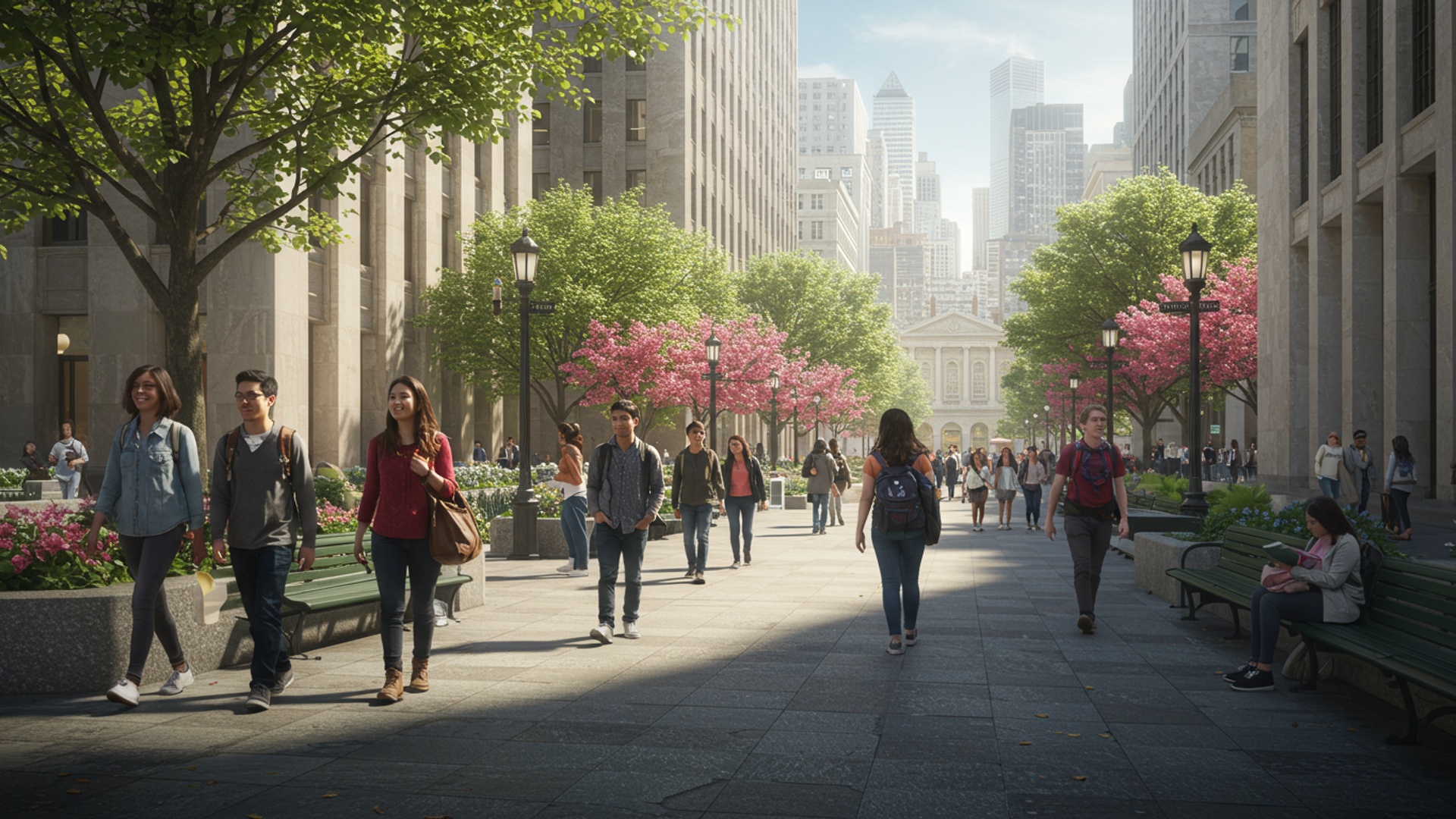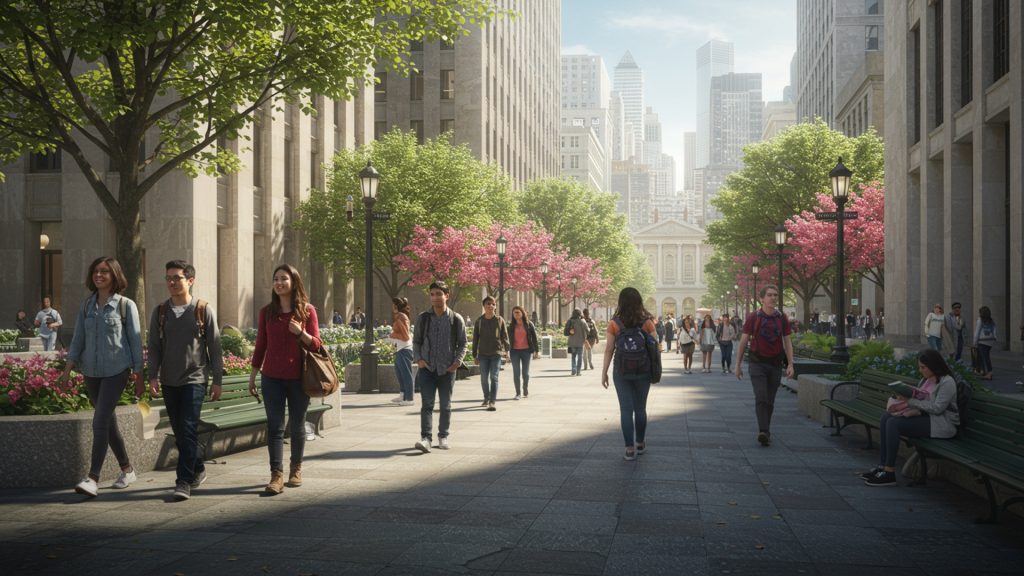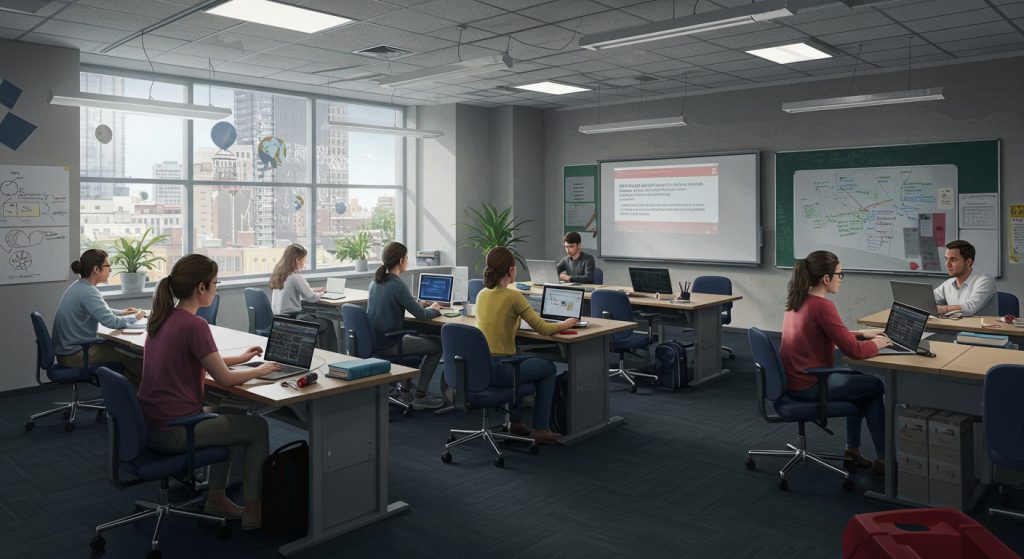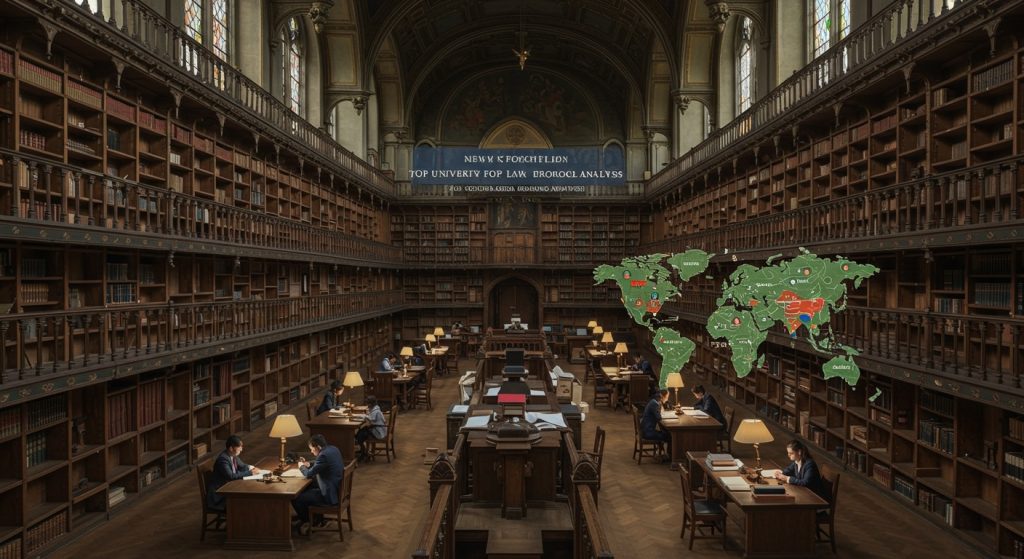Columbia University’s Morningside Heights campus, uniquely integrated within New York City’s vibrant tapestry, actively transforms the metropolis into an expansive, living laboratory for its students. They directly leverage the city’s unparalleled opportunities, from securing competitive finance internships on Wall Street to conducting cutting-edge research at the Manhattanville campus’s Jerome L. Greene Science Center, reflecting recent institutional expansion into new urban ecosystems. This dynamic immersion provides a distinct competitive advantage, fostering the practical application of theoretical knowledge amidst a global hub. Strategic engagement within this dense, opportunity-rich environment is crucial, propelling career trajectories and shaping understanding of current socio-economic shifts and technological paradigms.

Understanding Columbia’s Unique Campus Layout
Unlike many universities nestled in sprawling, self-contained environments, Columbia University offers a distinct experience: a vibrant, urban campus seamlessly integrated into the fabric of New York City. At its heart lies the historic Morningside Heights campus, an architectural marvel designed by McKim, Mead & White. Here, neoclassical buildings and expansive green spaces create a traditional collegiate atmosphere. with a crucial difference—its boundaries are city streets, not isolated gates.
This integration means that stepping off campus often means stepping directly into a bustling neighborhood. Morningside Heights itself is a diverse area, blending academic life with local businesses, restaurants. cultural institutions. But Columbia’s presence in NYC extends far beyond this central hub:
- Morningside Heights Campus
- Columbia University Irving Medical Center (CUIMC)
- Manhattanville Campus
The main undergraduate and many graduate schools are located here, offering iconic landmarks like Low Library, Butler Library. College Walk.
Located in Washington Heights, this campus is a world-renowned hub for medical education, research. patient care, connected to the main campus by a short subway ride.
Situated just north of Morningside Heights, this newer campus is home to schools like the Jerome L. Greene Science Center (Mortimer B. Zuckerman Mind Brain Behavior Institute) and the Lenfest Center for the Arts, representing Columbia’s commitment to cutting-edge research and artistic expression.
This multi-campus structure and urban immersion mean that your “campus” is, in many ways, all of New York City. Students at Columbia University learn to navigate not just academic buildings but also subway lines, diverse neighborhoods. the city’s vast network of resources. It’s an experience that fosters independence, adaptability. a deep understanding of urban dynamics from day one.
Harnessing NYC’s Academic and Research Ecosystem
For students at Columbia University, the classroom truly extends beyond four walls. New York City itself serves as an unparalleled living laboratory and a gateway to world-class academic and research opportunities. This isn’t just about visiting a museum; it’s about active engagement and direct access to leading institutions and experts.
- Unrivaled Research Opportunities
- Internships Galore
- Access to Experts
- Cultural and Educational Institutions
Imagine a political science student conducting research at the United Nations, just a short subway ride away, or an engineering student collaborating with researchers at a tech startup in Silicon Alley. Columbia’s location facilitates partnerships with hospitals, research centers. laboratories across the city.
NYC is a global capital for finance, media, fashion, arts, technology. non-profits. This translates into an astonishing breadth of internship opportunities. Students can gain invaluable real-world experience at companies ranging from Fortune 500 giants to innovative startups, often leading directly to post-graduation employment.
The city is constantly buzzing with guest lectures, seminars. conferences featuring global leaders, Nobel laureates, artists. innovators. Students at Columbia University often have the chance to attend these events, offering insights and networking opportunities that are simply unavailable elsewhere.
Beyond internships, New York’s museums (like the Metropolitan Museum of Art, MoMA, American Museum of Natural History), libraries (New York Public Library system). performance venues become extensions of the learning environment. Art history students can study original works, while aspiring playwrights can see their craft performed on Broadway.
For example, a student in the School of Engineering and Applied Science might intern at Google’s NYC office, applying classroom knowledge to real-world software development projects. Simultaneously, a student from Barnard College (affiliated with Columbia University) could be interning at a major publishing house, gaining hands-on experience in the literary world. These direct applications of learning are a hallmark of the Columbia experience in New York City.
Embracing the Cultural Tapestry and Social Life
Life at Columbia University isn’t just about academics; it’s also about immersing yourself in one of the most culturally rich and diverse cities on Earth. New York City offers an unparalleled backdrop for social exploration and personal growth, making your college years an adventure both inside and outside the classroom.
- Endless Entertainment
- A Culinary Journey
- Diverse Communities
- Student Organizations Leveraging the City
Whether your passion is Broadway shows, indie music concerts, stand-up comedy, or underground art exhibits, NYC has it all. Students can catch a Yankees game, explore Central Park, visit historic sites, or discover hidden gems in neighborhoods like Greenwich Village or Brooklyn.
From Michelin-starred restaurants to diverse food trucks and authentic ethnic eateries in every borough, New York City is a foodie’s paradise. This provides an incredible opportunity to explore global cultures through cuisine, often at student-friendly prices.
The city’s immense diversity is reflected on campus and in the surrounding neighborhoods. This fosters an inclusive environment where students from all backgrounds can find community and expand their perspectives by interacting with people from around the globe.
Columbia boasts hundreds of student clubs, many of which take full advantage of the city. A photography club might organize shoots in iconic locations, a volunteer group might partner with a local non-profit, or a debate team might attend a UN session.
Balancing rigorous academics with the allure of NYC requires intentionality. Many students find that effective time management, including dedicated study blocks and scheduled city adventures, allows them to thrive. Weekends are often for exploring, attending events, or simply wandering through new neighborhoods, while weekdays are focused on classes and campus activities. This balance is key to maximizing the unique social and cultural benefits of attending Columbia University.
Navigating Logistics: Transportation and Safety
Living and studying at Columbia University means becoming adept at navigating a major metropolis. Understanding New York City’s public transportation system and practicing urban safety are essential skills that students quickly acquire.
Public Transportation: The MTA
The Metropolitan Transportation Authority (MTA) is the lifeline of New York City, comprising an extensive network of subways and buses. For Columbia students, the subway is often the quickest and most efficient way to travel throughout the city. Morningside Heights is well-served by the 1 train, which has stops directly adjacent to the main campus.
- Subway
- Buses
- Biking and Walking
The iconic New York City Subway operates 24/7, connecting all five boroughs. Students typically use a MetroCard (rechargeable fare card) or tap-to-pay with OMNY (One Metro New York) system using a credit/debit card or smartphone. Understanding which lines go where. how to transfer, becomes second nature.
Buses fill in gaps where subway lines don’t reach or offer a more scenic route. They are particularly useful for shorter distances within a neighborhood or for reaching destinations not directly on a subway line.
For nearby destinations, walking is a great way to explore. Bike shares and personal bikes are also popular, though navigating city traffic requires caution.
Download a reliable NYC subway map app (like “Citymapper” or “Transit”) on your phone. These apps provide real-time details, directions. estimated travel times, making urban navigation much easier.
Safety in an Urban Environment
New York City, like any major urban center, requires a degree of street smarts. Columbia University takes student safety very seriously, offering numerous resources:
- Columbia Public Safety
- Blue Light Phones
- Emergency Notification System
- General Urban Safety Practices
- Be aware of your surroundings, especially at night.
- Travel with friends when possible.
- Keep valuables out of sight.
- Trust your instincts; if a situation feels unsafe, remove yourself.
- Utilize well-lit, populated routes.
The university operates its own Public Safety department, providing 24/7 patrols, emergency response. security services across all campuses. They offer a “Walking Escort” service for students traveling on or near campus late at night.
Emergency call boxes are strategically placed around campus, offering direct access to Public Safety.
Columbia has an alert system that sends text, email. phone notifications in case of campus-wide emergencies.
By learning to use the MTA efficiently and being mindful of personal safety, students at Columbia University can confidently explore and enjoy all that New York City has to offer.
Building a Professional Network in the Global Hub
One of the most significant, yet often underestimated, advantages of attending Columbia University is the unparalleled opportunity to build a robust professional network within a global economic and cultural powerhouse. New York City isn’t just a backdrop for your education; it’s a launchpad for your career.
The Columbia Alumni Network
Columbia boasts one of the most extensive and influential alumni networks in the world, with a particularly strong presence in New York City. Alumni are often deeply invested in helping current students and recent graduates. This network spans every conceivable industry, from finance and tech to arts, media, law. public service.
- Mentorship Programs
- Networking Events
- Informational Interviews
Many departments and university-wide initiatives connect students with alumni mentors who can offer guidance, industry insights. career advice.
Alumni associations regularly host events both on and off campus, providing informal and formal opportunities to meet professionals in various fields.
The shared Columbia identity often opens doors for informational interviews, allowing students to learn about different career paths and make valuable connections.
Career Services Leveraging NYC Connections
Columbia’s various career services offices (central career services. those specific to individual schools like Engineering, Business, Law, etc.) are expertly positioned to leverage the university’s location. They actively cultivate relationships with employers across NYC, from multinational corporations to innovative startups and non-profits.
- On-Campus Recruiting
- Job and Internship Fairs
- Employer Spotlights & Industry Panels
Many top companies conduct interviews and data sessions directly on campus, specifically targeting Columbia University students.
Career fairs bring a diverse range of NYC-based employers to campus, offering direct access to recruiters.
These events often feature professionals working in the city, providing insights into specific industries and roles.
Industry Events and Conferences
New York City is a hub for conferences, industry meetups. professional events year-round. Students can attend these, often at discounted rates, to stay abreast of industry trends, learn from leaders. expand their network beyond the immediate Columbia community.
Comparison: NYC vs. Isolated Campus Networking
| Feature | Columbia University (NYC) | Traditional Isolated Campus |
|---|---|---|
| Alumni Accessibility | High density of alumni in the city, easy to meet in person. | Alumni spread out, often requiring more remote communication. |
| Internship Opportunities | Vast and diverse, often within commuting distance; many paid. | May require relocation, fewer options in immediate vicinity. |
| Industry Exposure | Constant exposure to major industries, events. trends. | Limited to campus-based events or specific industry visits. |
| Networking Events | Frequent industry events, meetups. professional gatherings across the city. | Primarily campus-organized events; fewer spontaneous opportunities. |
| Mentorship Prospects | Easier to find local mentors for face-to-face interaction. | Often relies on virtual or less frequent in-person meetings. |
The sheer proximity to major industries and decision-makers means that networking at Columbia University is often more direct, more frequent. more impactful. Students are not just preparing for a career; they are actively building one from their first year, leveraging the dynamic environment of New York City.
Real-World Application: Student Success Stories
The true power of attending Columbia University in New York City is best illustrated through the experiences of its students. These are not just theoretical advantages; they are tangible opportunities that shape academic journeys and career paths. Here are a few hypothetical, yet highly representative, examples:
- The Tech Innovator
- The Aspiring Curator
- The Public Health Advocate
- The Aspiring Journalist
Maria, an undergraduate studying Computer Science at Columbia Engineering, always dreamed of working in a tech startup. During her sophomore year, she leveraged Columbia’s career services to secure a summer internship at a rapidly growing AI firm in Silicon Alley (NYC’s tech hub). Her daily commute involved a quick subway ride, allowing her to apply her classroom knowledge to real-world product development. By her senior year, her network from the internship, coupled with connections made at NYC tech meetups, led to multiple job offers from leading tech companies, including a full-time position at her former internship firm.
David, a student at Columbia College majoring in Art History, was passionate about museum work. His professors encouraged him to explore the city’s vast cultural institutions. Through a Columbia-affiliated program, he interned at the Metropolitan Museum of Art, assisting with exhibition research and collection management. This experience, combined with a later internship at a contemporary art gallery in Chelsea, provided him with practical skills and a professional network that helped him secure a competitive post-graduate fellowship at a prestigious art institution, a direct result of his hands-on NYC experience.
Chloe, a Public Health student, was deeply interested in urban health disparities. For her master’s thesis, she partnered with a community health organization in Harlem, just a few subway stops from the Morningside campus. She spent months conducting field research, interviewing residents. analyzing data on local health outcomes. Her ability to directly engage with a community facing real-world health challenges, facilitated by Columbia University’s connections and the city’s diverse populations, allowed her to produce a highly impactful and actionable study that gained recognition from local policymakers.
Ben, studying at the Columbia Journalism School, took full advantage of New York City’s media landscape. He regularly attended press conferences, covered local events for the student newspaper. secured a highly sought-after internship at a major news network’s NYC bureau. His ability to be on the ground, reporting live from the city. interacting with seasoned journalists provided invaluable experience that directly launched his career as a broadcast reporter upon graduation.
These stories underscore a fundamental truth: attending Columbia University isn’t just about earning a degree; it’s about leveraging a world-class education within a global epicenter of innovation, culture. opportunity. The city becomes an integral part of the learning process, transforming students into globally aware, highly adaptable. well-connected professionals.
Actionable Takeaways for Prospective Students
Considering Columbia University means preparing for an educational journey that extends far beyond traditional campus boundaries. To truly unlock the opportunities presented by its dynamic New York City setting, here are some actionable steps and mindset shifts for prospective students:
- Visit Strategically
- Research NYC Connections for Your Major
- Cultivate an Explorer’s Mindset
- Develop Urban Navigation Skills
- Highlight Urban Engagement in Your Application
- Budget for City Life
- Embrace Independence and Adaptability
If possible, plan a campus visit that extends beyond the typical tour. Explore Morningside Heights, take a subway ride downtown. visit a museum or neighborhood that aligns with your interests. This will give you a better feel for living in an urban environment and how Columbia University integrates with it.
Don’t just look at Columbia’s academic programs; investigate how those programs leverage the city. Does the architecture program have studios in historic buildings? Does the film program connect students with industry professionals in Tribeca? Understanding these links will highlight the unique value proposition.
Be prepared to view New York City as an extension of your classroom and your social life. This means being proactive in seeking out internships, attending city events. exploring diverse neighborhoods. The most successful Columbia students are those who are curious and courageous enough to venture beyond campus.
Start familiarizing yourself with public transportation concepts. While you don’t need to be an expert immediately, understanding how the subway works will be a crucial skill. Consider watching videos or reading guides on NYC transit.
If you’ve lived in or interacted with urban environments, or if you have a clear vision of how you’d use NYC’s resources, articulate this in your essays. Demonstrating an understanding of and enthusiasm for Columbia’s unique urban setting can strengthen your application.
New York City can be expensive. While Columbia University provides resources and financial aid, understanding the cost of living and planning your personal finances will be vital. Look for student discounts, free city events. affordable dining options.
Living in a major city requires a degree of independence and the ability to adapt to new situations. Columbia students thrive when they embrace these challenges as opportunities for growth.
Choosing Columbia University is choosing an education intertwined with one of the world’s most exciting cities. By being intentional, proactive. open to the vast possibilities around you, you can truly make the most of this extraordinary experience.
Conclusion
Embrace Columbia’s urban campus not merely as a place of study. as your extended classroom and an unparalleled launchpad. My personal tip is to view the subway system not just as transportation. as a daily passport; it’s your gateway to diverse neighborhoods, from the historic vibrancy of Harlem to the entrepreneurial buzz of Silicon Alley, each offering unique cultural immersion and invaluable networking prospects. Don’t limit your horizons to campus; actively seek out real-world experiences, whether it’s a startup internship or a community initiative. This blend of rigorous academics and dynamic city engagement is precisely how you’ll cultivate the adaptability and strategic thinking essential for thriving in future management careers by 2025. Ultimately, Columbia’s New York City setting isn’t just a backdrop; it’s an active participant in your growth, challenging you to push boundaries and define your unique impact. Go forth, explore. let this vibrant city amplify your journey.
More Articles
Mastering the IELTS Online Test: Essential Tips for Boosting Your Score Significantly
Stanford’s Entrepreneurial Hub: Launching World-Changing Startups from Campus to Valley
Navigating Postgraduate Study in the UK: A Practical Guide to Funding Your Dreams
FAQs
How tough is it to get around Columbia’s campus and then into the rest of NYC?
Navigating campus is pretty straightforward! Most of Columbia’s main campus is very walkable, making it easy to get between classes and facilities. For venturing into the city, we’re super lucky to have direct subway access right at our doorstep, like the 1 train. This makes exploring Manhattan and beyond quick and convenient, whether you’re heading downtown for an internship or uptown for a museum.
Is New York City really safe for students, especially at night?
NYC is a vibrant, bustling city. like any major urban area, it’s wise to be aware of your surroundings. Columbia takes student safety very seriously, with 24/7 campus security, blue light phones. escort services available. Many students travel in groups, especially at night. utilizing public transport or ride-shares is common. Generally, sticking to well-lit, populated areas and being mindful of your belongings are good practices.
What are some cool ways students can really take advantage of being in New York City?
Oh, the opportunities are endless! Beyond academics, students often dive into internships at major companies, startups, or non-profits. You can catch Broadway shows, visit world-class museums (many offer student discounts or free days!) , explore diverse neighborhoods for amazing food, or attend countless cultural events and concerts. The city itself becomes an extension of your classroom and social life.
It seems like there’s so much to do! How do students balance their studies with all the city has to offer?
It’s definitely a juggling act. a rewarding one! Most students learn pretty quickly how to manage their time effectively. It often involves creating a schedule, prioritizing academics. then strategically planning city adventures. Many find that joining campus clubs or groups helps build community while also providing structured social outlets. It’s all about finding your rhythm and sometimes saying ‘no’ to ensure you’re getting enough rest and study time.
Will I feel lost in such a huge city? How do I find my people and community at Columbia?
While NYC is massive, Columbia’s campus itself feels like its own vibrant neighborhood. it’s full of community-building opportunities. There are hundreds of student organizations, from academic and cultural groups to sports and performance clubs. Residential life also plays a big role in connecting students. Don’t be shy about attending orientation events, department meet-and-greets. club fairs – you’ll find your niche pretty quickly!
What’s the deal with food and everyday necessities around campus?
You’re in luck! Columbia offers a variety of dining halls and cafes right on campus to keep you fed. Beyond that, the surrounding Morningside Heights neighborhood is packed with diverse restaurants, coffee shops. grocery stores like Westside Market and Morton Williams for all your daily needs. Plus, being in NYC means endless delivery options for anything your heart desires!
I’m not used to big city life. What advice do you have for someone new to an urban campus like Columbia’s?
Embrace the energy! New York City is incredibly dynamic. that’s one of its biggest strengths. Start by exploring your immediate surroundings in Morningside Heights. Don’t be afraid to ask for directions. definitely take advantage of campus resources and orientation programs designed for new students. Most importantly, stay open to new experiences. also remember to take breaks and find your own quiet spots when you need them. You’ll adapt faster than you think!



